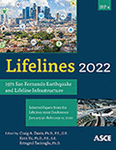Evaluating the Importance of Interdependent Civil Infrastructure System Components for Disaster Resilience of Community Housing
Publication: Lifelines 2022
ABSTRACT
Housing disaster resilience is crucial for community disaster resilience as it provides two essential functions: shelter from the elements and functional housing. We present a methodology to quantify community housing disaster resilience considering the unmet post-disaster community demand for both shelter and functional housing. Total Sobol’ indices are used to evaluate the importance of the vulnerability and recoverability of individual components of community infrastructure systems and building stock units for community housing disaster resilience, while requiring no prior knowledge of these component properties. We illustrate the application of the proposed importance analysis on a virtual community considering the functionality of the electric power supply, water supply and communication infrastructure systems, and a number of building stock units.
Get full access to this article
View all available purchase options and get full access to this chapter.
REFERENCES
Blagojević, N., Hefti, F., Henken, J., Didier, M., and Stojadinović, B. (2020a). “Quantifying Disaster Resilience of Communities with Interdependent Civil Infrastructure Systems”. In Preparation.
Blagojević, N., Didier, M., and Stojadinović, B. (2020b). “Quantifying Component Importance for Disaster Resilience of Communities with Interdependent Civil Infrastructure Systems”. In Preparation.
Comerio, M. C. (2017). “Disaster Recovery and Community Renewal: Housing Approaches” in Coming Home after Disaster: Multiple Dimensions of Housing Recovery, A. Sapat & A.-M. Esnard (eds.). Routledge.
Didier, M., Broccardo, M., Esposito, S., and Stojadinović, B. (2018a). “A compositional demand/supply framework to quantify the resilience of civil infrastructure systems (Re-CoDeS)”. Sustainable and Resilient Infrastructure, 3(2), 86–102. https://doi.org/10.1080/23789689.2017.1364560.
Didier, M., Broccardo, M., Esposito, S., and Stojadinović, B. (2018b). “Seismic Resilience of Interdependent Civil Infrastructure Systems”. Proc. 11 US National Conference on Earthquake Engineering.
EERI (Earthquake Engineering Research Institute). (2016). Creating Earthquake-Resilient Communities.
Kapur, J. N. (1989). Maximum-Entropy Models in Science and Engineering. New York: John Wiley and Sons.
Lauber, N. (2020). Modelling the Post-Disaster Housing Capacity of Communities. ETH Zurich.
McAllister, T., Clavin, C., Ellingwood, B., van de Lindt, J., Mizzen, D., and Lavelle, F. (2019). Data, information, and tools needed for community resilience planning and decision-making. NIST. https://doi.org/10.6028/NIST.SP.1240.
OECD. (2019). Good Governance for Critical Infrastructure Resilience, OECD Reviews of Risk Management Policies, OECD Publishing, Paris. https://doi.org/10.1787/02f0e5a0-en.
RRMC (Risk and Resilience Measurement Committee). (2019). Resilience-Based Performance: Next Generation Guidelines for Buildings and Lifeline Standards. ASCE.
Homma, T., and Saltelli, A. (1996). “Importance measures in global sensitivity analysis of model output”. Reliab. Eng. Sys. Safety, 52 (1), 1–17.
Saltelli, A. (2002). “Making best use of model evaluations to compute sensitivity indices”. Computer Physics Communications, 145 (1), 280–297.
Sattar, S., McAllister, T., Johnson, K., Clavin, C., Segura, C., McCabe, S., Fung, J., Abrahams, L., Sylak-Glassman, E., Levitan, M., Harrison, K., and Harris, J. (2018). Research Needs to Support Immediate Occupancy Building Performance Objective Following Natural Hazard Events. NIST. https://doi.org/10.6028/NIST.SP.1224.
Sobol, I. M. (1993). “Sensitivity Estimates for Nonlinear Mathematical Models”. Mathematical and Computer Modelling, 1(4), 407–414.
Sobol, I. M. (2001). “Global sensitivity indices for nonlinear mathematical models and their Monte Carlo estimates”. Mathematics and Computers in Simulation, 55(1–3), 271–280. https://doi.org/10.1016/S0378-4754(00)00270-6.
SPUR (San Francisco Planning and Urban Research Association). (2009). Defining Resilience: What San Francisco Needs From its Seismic Mitigation Policies.
SPUR (San Francisco Planning and Urban Research Association). (2012). Safe Enough to Stay.
UNISDR (United Nations International Strategy for Disaster Reduction). (2015). Sendai Framework for Disaster Risk Reduction 2015-2030.
Information & Authors
Information
Published In
History
Published online: Nov 16, 2022
Authors
Metrics & Citations
Metrics
Citations
Download citation
If you have the appropriate software installed, you can download article citation data to the citation manager of your choice. Simply select your manager software from the list below and click Download.
